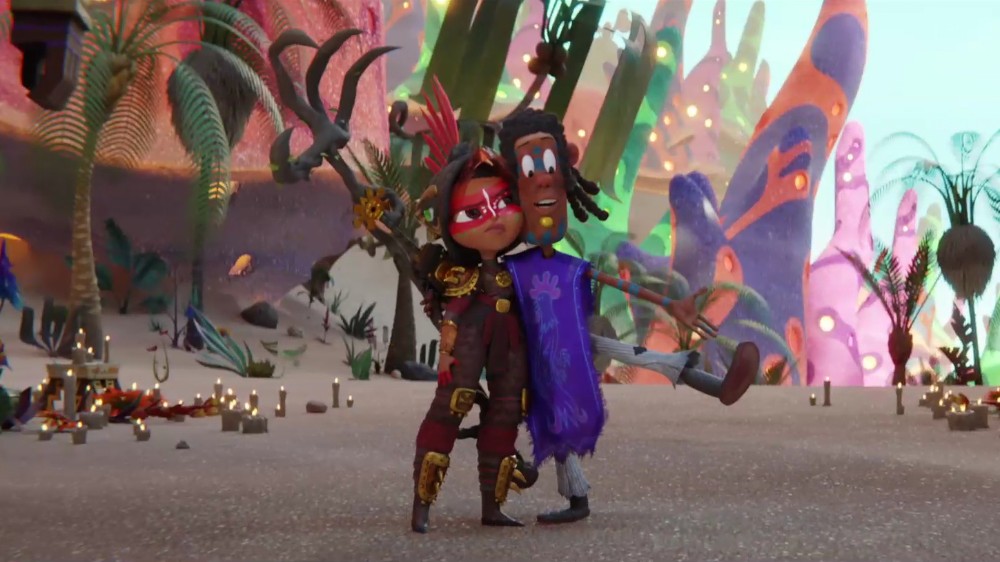
Tim Davies is one of those rare composers who does it all, using his background as an orchestrator, arranger, and conductor on many big movies and TV shows to carve out a career for himself — a career that includes working on the music for animated shows such as Guillermo del Toro’s Trollhunters and Jorge Gonzalez’s Maya and the Three, both of which are on Netflix.
Davies’ instrumentation for both shows runs the gamut, but Maya has allowed Davies to play with different Mexican musical genres, from the more traditional to something called “Mexican thrash polka,” in following the journey of 15-year-old warrior princess Maya, who must face off against a number of underworld gods along with three other warriors. The animated series was recently nominated for an Annie Award for its music.
Below the Line spoke to Davies a while back and he explained how his background as an arranger and conductor has helped him thrive as a composer for film and television. I hope you enjoy our interesting conversation below:
Below the Line: I know you’ve been working in the music department for roughly 20 years, conducting and arranging as well as composing. How did you end up working on all these scores as an arranger and conductor at first before you started composing?
Tim Davies: I came out [to L.A.] in ’98 to study — actually, I studied film score at USC — and I did that pretty much just as an academic exercise, just to learn. I wasn’t planning on staying, and my goal in life was never actually to be a film composer. I was an arranger/composer. I had my big band, and I was just a musician, but I loved arranging, and that was kind of what I was doing. I came out here to study, and I was gonna go home, and then, I sort of found a world of orchestrating for films here. Historically, the people like me in the past, they were arrangers and conductors, and they were the orchestrators as well. So I thought, ‘Oh, this is perfect for me,’ and I decided that’s what I was going to do. I became an orchestrator and then worked my way up, and I guess I’m like one of the top people now in that side of the world, and then I do my conducting, and I always have arranged for various things.
And then, through that, when there were musicals and song scores, the orchestrator/arranger would often take things from the songs and write underscore based on that. That’s what I actually ended up doing on the Book of Life, working with Gustavo [Santaolalla] and Jorge, the director, taking songs that Gustavo had written and themes, and then turning them into underscore cues. That sort of led to Guillermo del Toro hearing what I did, and then he invited me to work on a few projects like Trollhunters, and now we’re back to Maya and the Three with Gustavo and Jorge from Book of Life. That’s how I ended up composing, and then right now, I’m scoring some episodes of Guillermo’s new Cabinet of Curiosities, which is like an anthology show.
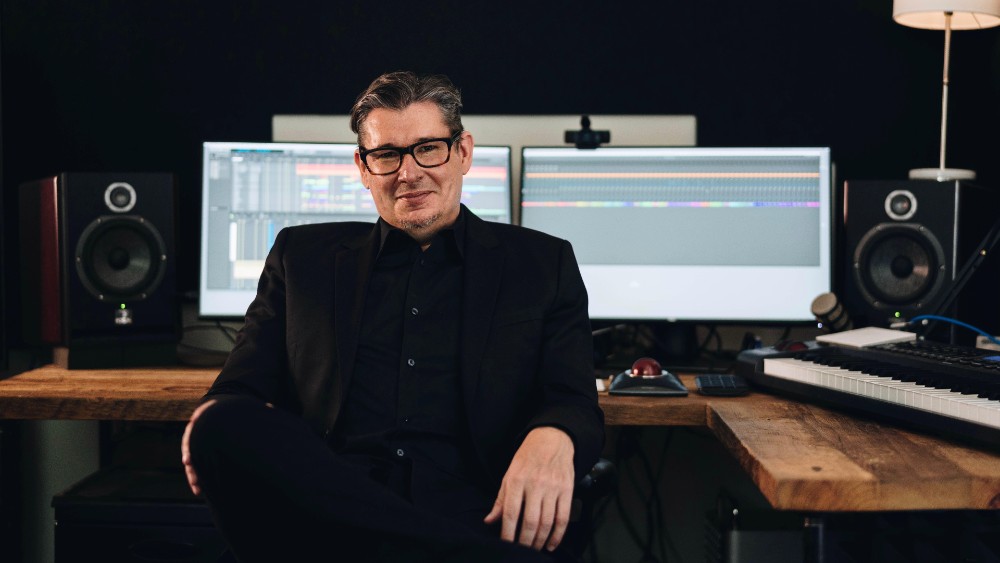
BTL: That sounds very organic in the way that Book of Life led to a lot of what you’re doing now.
Davies: It definitely did. I actually met Gustavo on a video game called The Last of Us with Sony Interactive. I’ve worked with them for many, many years, so they’ve brought me in on a lot of projects to just do various things, to orchestrate, conduct, or arrange things. They brought me in to work with Gustavo on that game, to just create things based on what he had created. That’s sort of how I ended up on the Book of Life, and meeting Jorge and Guillermo. So yeah, it was quite organic, one of those right place, right time things, especially getting noticed by Guillermo. All the big composers that I work for, as an orchestrator and conductor, pretty much anyone would love to work with Guillermo, so that’s pretty cool how that all worked out. I’m sitting here this week actually, juggling that, because I’ve got my other job going. We’ve got the last episode of Hawkeye, which is the new Marvel TV show, recording tomorrow, so I’m busy orchestrating and looking over that as well.
BTL: One of my other questions was going to be about juggling composing with your work on all those Marvel shows. Your story is a little different from other composers I’ve spoken to since you come from the world of conducting and arranging and orchestrating.
Davies: I’ve always positioned myself as the orchestrator that doesn’t want to be a composer, so it’s funny that I’ve ended up sort of doing it. A few of [the composers I’ve worked with] have sort of said, ‘Hey, I remember you told me that you didn’t want my job.” Which was one of my lines to always get the gig as orchestrator. I’m like, ‘You don’t have to worry about me. I’m quite happy.’ Because a lot of orchestrators are just sort of biding time until they get their break as a composer.
BTL: One composer I spoke to said he had trouble getting seen as more than an assistant or an arranger since filmmakers and showrunners mostly knew him from that role.
Davies: The people that I work with as an orchestrator, I am just an orchestrator. I don’t write additional music for them. They don’t speak of me as a composer. They know I can do it, and they appreciate that I can jump in and tweak and fix anything. I use those skills all the time when I’m conducting [or] when a change has to be made and I have to come up with something on the spot. To get the composing break, you kind of need something else to happen, so for me, it was just ending up in that role on the Book of Life, and then Guillermo really loving what I did, and then going from there. To that extent, I don’t orchestrate my own music when I write. I do the initial version in the computer where I’ve sort of selected what instruments I want, but my normal day job is taking that and making the decisions of how that’s going to work with the live players. I have other people do that for me.
BTL: I haven’t watched the entire season of Maya, but I did listen to the soundtrack, and I was curious why there are different composers listed on the soundtrack record?
Davies: How it worked was, Gustavo wrote a bunch of themes early on with Jorge, the director. They went through, and they did all that. Then we had a meeting in the beginning, and then he went off, and then I took over and wrote the score using those themes where I could, and then coming up with new ones where I needed other things, and that’s how it works. That explains Gustavo, and the other name on there I think is Juan Carlos Enriquez, [who] helped out with a few of the more Mexican things that I needed.
There’s a recreation of Jorge’s favorite folk song called “Bolom Chon,” which JC helped me with because he had connections in Guadalajara and Mexico to pull it all off, because it had to sound quite traditional. I’m pretty good at taking lots of influences and mixing it up and outputting something unique, but in that case, we needed something to sound traditional, so he did that. And I had him do a few other little things for me on the score, so he was like additional music, so that hopefully explains the names.
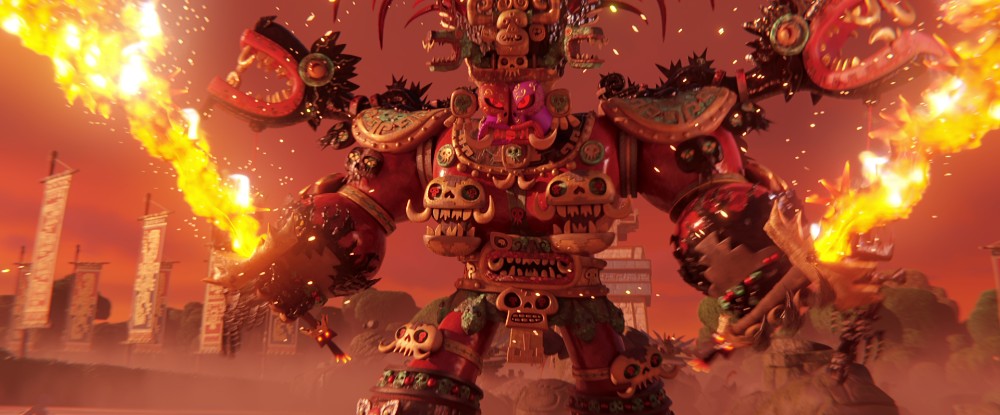
BTL: For a series like Maya or Trollhunters, at what point do you start writing? Do you get a rough edit or rough animation so you can start writing music?
Davies: It’s funny how I sort of came into this. I’ve always ended up working with other people’s material and themes, so on Trollhunters, I worked with some themes by Alexandre Desplat, who is amazing. It made my life so easy in all of these cases, honestly, because the material I’ve been given has been so good that it’s like stealing candy from a baby, because I’m given that and then I sort of plugged that in. Like I said earlier on, I’m good at absorbing lots of different things, and then coming up with something unique based on all that.
An ingredient of that is the theme, whether I come up with it myself or am given it, that’s an important part. But I can work with it equally, being an arranger, that’s what arrangers do, is they take some existing material and add to it, or change it or work with that. But that’s the role. So I’ve always had that skill, and I’m really happy to do it, but in the case of Maya, Gustavo started and he wrote some themes, and he came up with some demos. You can hear those demos on the soundtrack, actually. If you compare the Gustavo tracks from the demos, which don’t really end up in the show. There are a few snippets in there, but they’re just what he presented and then how I combine that with everything else to make the score.
It’s kind of a unique comparison that you can hear on that album. You don’t usually get to hear the pre-workings. You hear the opening is Gustavo’s Maya theme. Well, that version actually never appears exactly in the show. I definitely take the tune and some of the elements that he used in that, to form other cues throughout the show. I pride myself in being [able to] pick every little bit of meat off the chicken and use it in some way, or just spin a cue out of some bit that you wouldn’t even recognize and turn it into … In the Book of Life, there was a song called “I Love You Too Much.” And the first line of the bridge, I just took that and turned that into the love theme for the whole movie. Now, you probably wouldn’t even recognize that’s what I did, but that’s where I got it from. I started with those four notes and then went from there. So, I got the material from Gustavo, we had a meeting and talked about it, and he had some really cool ideas of what instruments we might use for different characters in different regions. So I took all that on board. I saw some early versions of it Jorge was sending me, but we actually started with episode two, and we ran it all out of order.
By the time I actually put pen to paper, so to speak, it was locked. It wasn’t completely lit, there was animation coming in, but the timings were all set. After that initial meeting, where we discussed all the music, Gustavo then went back to his own music and other shows, and his touring and stuff, and I just dealt with Jorge, going through the process, so we spot the episode — there was a temp score in there. I actually had my music editor, as soon as we got the Gustavo things, he went through and temped in just for ideas that music where we could. And then some of that, actually, did stay, little snippets of it, but then, we’d spot it and then I would just start writing. And then we’d have a playback meeting. We did it all obviously online, because of the pandemic. We missed the social aspect of it, but it actually made it very efficient, because we’d all jump on Meet. The music editor would send a version of the show with music tracked in and mixed from us, and then Jorge would play that back on his computer, so he’s hearing it pristine. Then, he would just talk us through it, what he liked, what tweaks we could make, and we did it all online, and then, it could be recorded. So if we had any questions or queries, we could always just go back and check the tape. Within the hour, we’d be done, instead of driving halfway across town and waiting for everyone, losing a whole day in LA traffic, or half a day, at least.
So that’s how it worked, and then we’d write it, and then we would have one big playback meeting where we’d go over spotting. I’d write, and then we’d have a playback, and then we would just send back another version with any tweaks, though very minor. Actually, Jorge and Andres Locsey, my music editor, would just go over it one more time quickly to find out any more tweaks, but it was kind of rare that we had more than two tweaks to make or more than one.
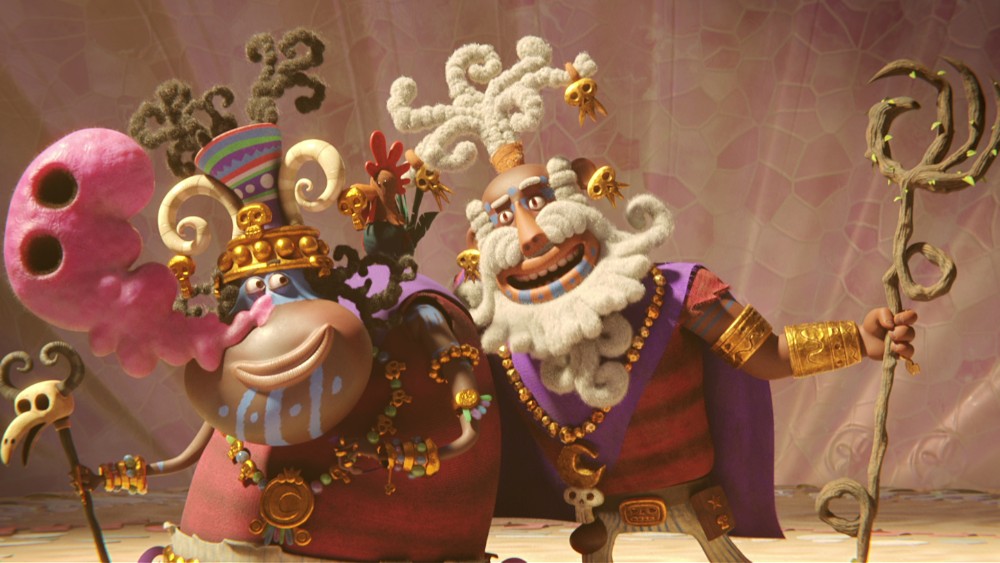
BTL: Do you do most of your writing on the computer first? Are you doing any recording with live instruments or orchestra before these meetings? Are you spotting stuff with computer-based demos, or are you spotting with later after recording the live instruments?
Davies: Most of the stuff in the playback is just to computer versions. Occasionally, if it was something I really needed to sell or it was just never going to work with the computer, I would just go out on a limb and spend the money and hope we could keep it. There were some vocals in the big final scene. Jorge wanted kind of a song-like thing, and I knew I couldn’t do that properly with a computer voice so I actually had my friend Suzanne [Waters], who adds her voice in the end, she did it, so I had that all recorded, and it did stay. Didn’t have to change it at all, and then some guitar.
There’s a whole sequence in Episode Six. Jorge’s idea was he wanted Carmen [from] Bizet, the music from “The Habanera” to be the theme… Each episode, he would have a different crazy idea. One was Carmen, another one was Mexican ska music in Episode 3. Episode 4 was Mexican thrash polka music that he wanted. For each of those episodes, for the fights, he had different ideas on what he wanted, and each time I was like, “What? How am I going to do that? Mexican ska?” I just listened to a bunch of it, and then I wrote, and he loved it.
In fact, when I put together what was gonna be on the soundtrack, [I was told] you can only have 20 tracks, and I’m like, “Oh my gosh. I’m trying to cull down like four and a quarter hours down to an hour.” I did leave the Mexican ska out, but then Tim Ewing, the producer, was like, “We got to put that on.” So then Jorge wanted his Mexican thrash polka on there, as well, which actually Juan Carlos helped me with, so it wasn’t even me on that one. I think it makes me look good to Jorge to know I hired an expert to do that. I just supervised it and it came out great. Same with the “Bolom Chon” theme. It needed someone that knew more about indigenous music than I did. I listened to a bit, but that is one that I palmed off onto JC.
So with the Carmen thing, I needed some flamenco-ey kind of guitar to hold down the rhythm, like rhythmic nylon string stuff. Again, there’s just no way to get that intensity and vibe with the computer, so I had Nomad, my guitarist, put that down, and luckily, it all got approved and it stayed. There was another scene where Zatz and Maya are sort of fight-dancing. It was temped with Rodrigo y Gabriela, that guitar duo, so I did a version of one of our themes in that style, but I knew there was no way that I could pull that off in the computer, so I had Nomad put it down. And Jorge loved it, so [we] didn’t have to change it. The rest then… all the woodwinds and the solo violin, and the orchestra and the choirs went on later.
BTL: When you’re composing, are you doing that in notation form?
Davies: I do a bit of everything, but when it’s orchestral and harmonic music, I like to write a score first. So I write it, I spot it, work out the timings — Cubase is the program we use for that — find the beats and where I’m going to hit, where the climaxes are and all that, and then I go to another program called Finale, and I actually write the music there, just in pure notation. It can play back sounds, but it’s mainly just to hear that it’s working. It’s nothing like the sounds that are going to be you programmed for the demo, and then, actually, I like to go quickly through, so I then send that to my programmer, Ryan Humphrey, who’s been with me nearly 10 years now, actually. He knows exactly what to do with my stuff, so he then programs that. We have duplicate computer systems, so I can then open it up and hear it or tweak it or whatever. But if it’s more ambient, sound design-ey, textural kind of stuff, I will do that myself, because you’re playing and manipulating sounds. Sometimes, it’s a hybrid thing. I do like to get in there and tweak sounds and come up with cool noises and treatments of things. I’m not really a synthesizer guy, so I like to manipulate organic sounds. Even if it’s a sample of an instrument, it’s still organic, and then I will process it or tweak it or do whatever to get something unique, but it sounds organic.
For Maya, I made a bunch of samples of everything from those big brown seed pods that ended up being our main sort of ticker and shaker throughout the show, and then, I made my own log drum samples. All the drums are custom, they’re all my instruments, so it’s me playing, but programmed, in a way. And then, for Lord Mictlan, the bad guy, I wanted something sinister and droney, so I use the didgeridoo, an Australian one, so I had a friend play a couple of notes. I actually never used one note of what she sent me, but I process that. Pretty much every time the bad guy is on screen, there’s a didgeridoo going [makes didgeridoo noise]. Actually, the Mayans had didgeridoos. I know it’s associated mostly with Australian culture, but many, many cultures, and the Mayans, had what they called the “Mayan trumpet,” which is pretty much a didgeridoo
BTL: I had trouble figuring out in some places if they were live instruments or samples, so good job disguising that.
Davies: Well, yeah, it was all a blend, and then, we did go and put live orchestra on most of it. We didn’t have the budget to do everything. It’s just a fact of life. But I got good coverage, and then put it all together with the help of my engineer, Steve Kaplan, who then sort of blended it all back. It’s really common in film scoring when you need to sort of go to 11 — you need to mix the real orchestra with some fake orchestra, just to push it over the top; humans can only do so much. [chuckles] Especially when you’re doing something with animation, where they can do superhuman things, we can make an orchestra do superhuman things with technology. But it’s a lot of fun putting together all of those sounds, and that’s what gives it sort of a unique character, obviously, the orchestra and choir are very traditional. I wrote for it pretty much in a traditional way, but then by adding in those extra elements, you get something unique.
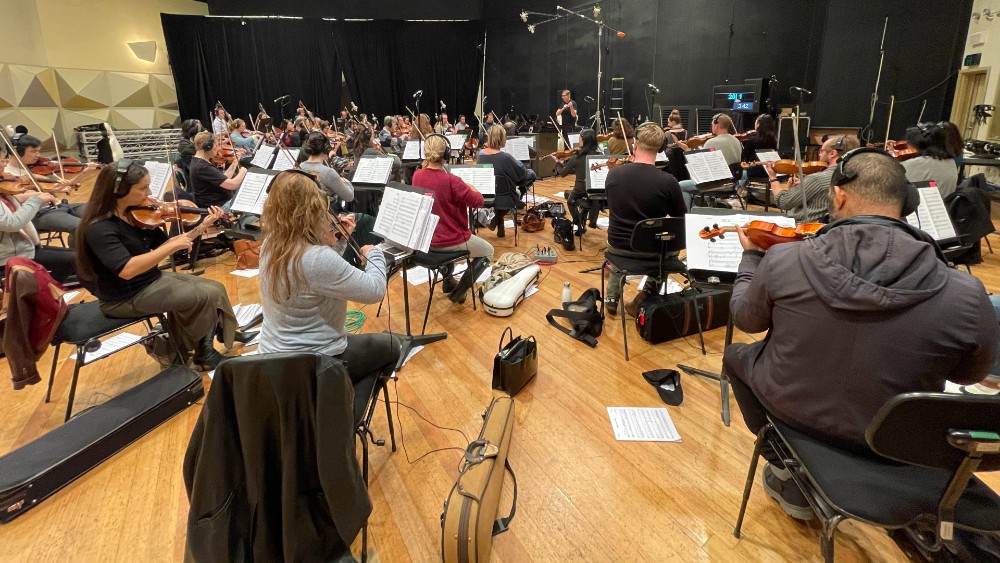
BTL: I asked before about balancing your composing and orchestrating, but I do want to ask about conducting, especially with COVID, which made it hard to do big orchestral sessions in L.A., so a lot of stuff has been outsourced to Vienna. How has the pandemic affected what you do?
Davies: I’ve got a session in Vienna tomorrow [chuckles], but I’m here. I was right in the thick of it, obviously, when all this went down, because we were in the middle of a bunch of projects. Every studio in the world shut down for a while, and L.A. was the last to come back online. We’d sort of seen the way everyone else was doing it by the time we came back. The first score we recorded back at a major studio in LA was Free Guy, which was Chris Beck, so I did orchestrate and conduct that one. Everyone’s spread out, and you’ve got all these other considerations. You can’t record the whole orchestra at once anymore, you could only have 50 people in the room total, which is really only like 44 players, because there’s the conductor, and there’s the copyist, and the contractor, and all these other people that have to be in the room. It’s super strict, but before we did that, we were producing stuff online.
I would normally go to London once every two months or something to record something, but I hired a stunt conductor, whose job was to do nothing, just to basically placeholder it, so they didn’t ever think that they could do without a conductor. [laughs] And if the connection went down, then he would take over. Actually, one day, we were doing Abbey Road, and the connection did go down, so the internet went down at Abbey Road, so I had Alfonso conducting and my friend, Jim MacWilliams, in the booth, so I had people there in case, and it did happen. They had me on FaceTime on his phone in the booth, but I couldn’t make out the sound at all, but they kept recording for like an hour until the Internet came back. But anyway, how I do it — because I’m just a control freak, too — I just talk directly to the orchestra. We have a conductor there, and the orchestra is used to having that figurehead there, that person who’s there who they look to and talk to and everything, so it is necessary. I do actually the answering of the questions and the shaping of it all. The technology is pretty damn good now. It was always a bit sketchy before the pandemic, and then, a bunch of companies … I mean, everyone’s seen how Zoom has progressed over the period.
There are other programs we use. There’s one called Audiomovers that streams, high-quality audio, and there are a couple of combined solutions, that combine high-quality secure video and high-quality audio and allow talkback and all that sort of stuff. The technology is there for us to pretend we’re in the booth, even though we’re on the other side of the planet. Also, you can talk directly to the orchestra. In fact, I worked out a way that by switching feeds, I could talk directly to the orchestra, or just to everyone else, so that the orchestra didn’t have to hear all of our offline discussions.
I got good at working out all that stuff, and you have to be a little more organized with the planning. I mean, really silly things like the orchestra is used to sitting a certain way, sharing music stands in the string section, so they know when extra notes appear, just by where they’re sitting, either on the outside of the section, or the inside, they know what they’re going to play. The minute you move everyone onto single stands and put them 1.5 meters away from each other, that reference is gone. They don’t know, automatically. A discussion has to be had, right? I have to print them all out, and I made all of these colorful drawings of string sections. Everyone’s got a number, and then it’s like, if it goes into two parts, you play this note. If it goes into three parts, you play this note, and if it goes into four parts, you play this note. Everyone’s got a big matrix, to work out what they play, so we don’t have to waste time working it out, because I’m super-organized and detailed with that sort of stuff.
We made it through. I actually had my busiest year ever last year, between doing a lot of online recording. I did make it to Australia to record The Mitchells vs. the Machines for Mark Mothersbaugh. I made it back again this year to record Maya in Australia, so I got to conduct that, which was really good. I got to go home and do it with fellow Australians, which was a blast. Apart from that, the odd session in town. Work is going. There’s a decent amount of sessions in town. I wouldn’t say it’s back to where it was, but it’s certainly getting there.
But everyone has to get tested for every project. We’re pretty free out on the street these days, but you go onto a studio lot, it’s still the same stuff that was around a year ago in the height of it. I understand they’ve gotta keep everyone safe, and there’s a lot of liabilities. It’s been good, but I’m hoping we get back to traveling pretty soon. A few people have made it over to London. I probably only made it to Australia, because I come from there, and it was my gig. No one else would have sent me.
The first season of Maya and the Three is available to stream via Netflix. The soundtrack is available on most streaming platforms and via digital download.





